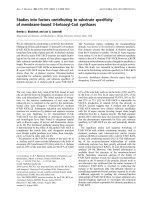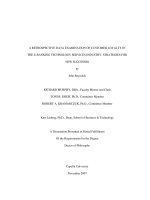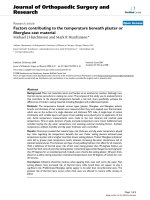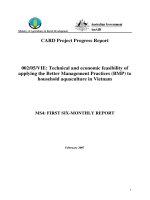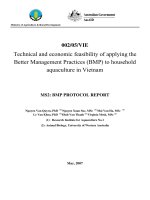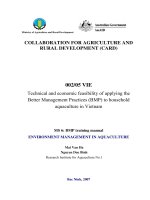Factors contributing to customer loyalty in vietnam industrial gases maket
Bạn đang xem bản rút gọn của tài liệu. Xem và tải ngay bản đầy đủ của tài liệu tại đây (1.06 MB, 83 trang )
UNIVERSITY OF ECONOMICS HO CHI MINH CITY
International School of Business
------------------------------
Phan Thanh Bình
FACTORS CONTRIBUTING TO
CUSTOMER LOYALTY IN VIETNAM
INDUSTRIAL GASES MARKET
MASTER OF BUSINESS (Honours)
Ho Chi Minh City – Year 2014
UNIVERSITY OF ECONOMICS HO CHI MINH CITY
International School of Business
------------------------------
Phan Thanh Bình
FACTORS CONTRIBUTING TO
CUSTOMER LOYALTY IN VIETNAM
INDUSTRIAL GASES MARKET
ID: 21110002
MASTER OF BUSINESS (Honours)
SUPERVISOR: Dr. VŨ THẾ DŨNG
Ho Chi Minh City – Year 2014
i
CONTENTS
CHAPTER 1: INTRODUCTION ............................................................................. 1
1.1
Research Background ............................................................................................... 2
1.2
Research Problems .......................................................................................... 3
1.3
Management Prolems ...................................................................................... 4
1.4
Research Objectives ........................................................................................ 6
1.5
Research Scope .......................................................................................................... 7
1.6
Structure of Research ................................................................................................ 7
CHAPTER 2 : LITERATURE REVIEW AND HYPOTHESIS ............................ 9
2.1
Definitions of Constructs ................................................................................ 9
2.1.1 Relationship quality ............................................................................... 9
2.1.2 Perceived service quality ...................................................................... 10
2.1.3 Customer satisfaction ........................................................................... 12
2.1.4 Customer loyalty .................................................................................. 13
2.2
Relationship between the constructs .............................................................. 18
2.2.1 The relationship between relationship quality, customer satisfaction
and customer loyalty ..................................................................................... 18
2.2.2 The relationship between perceived service quality, customer satisfaction
and customer loyalty ..................................................................................... 19
2.2.3 The relationship between customer satisfaction and
customer loyalty ............................................................................................ 19
ii
2.3
Conceptual Model ......................................................................................... 21
2.4
Hypothesis .................................................................................................... 21
CHAPTER 3 : RESEARCH METHODOLOGY .................................................. 23
3.1
Research Design ........................................................................................... 23
3.2
Measurement ................................................................................................ 23
3.2.1 Relationship quality.............................................................................. 23
3.2.2 Perceived service quality ...................................................................... 24
3.2.3 Customer satisfaction ........................................................................... 27
3.2.4 Customer loyalty .................................................................................. 28
3.3
Qualitative research ...................................................................................... 28
3.4
Quantitative research..................................................................................... 29
3.4.1 Quesionnaire design ............................................................................. 29
3.4.2 Sample size .......................................................................................... 30
CHAPTER 4 : DATA ANALYSIS AND RESULTS .............................................. 32
4.1
Data Statistical Analysis ............................................................................... 32
4.2
Reliability Test (Cronbach Alpha)................................................................. 33
4.3
Exploratory Factor Analysis.......................................................................... 36
4.4
Multiple Linear Regression ........................................................................... 39
4.4.1 Correlation Analysis ............................................................................. 39
4.4.2 Multiple Linear Regression analysis ..................................................... 41
4.5
Simple Linear Regression ............................................................................. 46
iii
CHAPTER 5 : CONCLUSION, IMPLICATION AND LIMITATION ............... 49
5.1
Conclusion .................................................................................................... 49
5.2
Implication .................................................................................................... 50
5.3
Limitations .................................................................................................... 51
REFERENCES ........................................................................................................ 53
APPENDIX 1A: Survey form (in English) ............................................................. 57
APPENDIX 1B: Survey form (in Vietnamese) ....................................................... 60
APPENDIX 1C: List of companies answering the survey ..................................... 63
APPENDIX 2: Data analysis result - EFA.............................................................. 67
APPENDIX 3: Data analysis result - MLR ............................................................ 70
APPENDIX 4: Data analysis result - SLR .............................................................. 74
iv
LIST OF FIGURES
Figure 1.1: Typical production plant, facilities and vehicles
of industrial gases industry. ............................................................................. 3
Figure 1.2: Main industrial gases manufacturers in the South of Vietnam. ................... 5
Figure 2.1: Conceptual model of business-to-business professional
service quality. ............................................................................................. 11
Figure 2.2: Chosing a loyalty strategy ........................................................................ 12
Figure 2.3: The conceptual framework of customer loyalty ....................................... 17
Figure 2.4: The relationship between customer satisfaction and loyalty ..................... 20
Figure 2.5: The conceptual model .............................................................................. 21
Figure 3.1: Research process ..................................................................................... 31
LIST OF TABLES
Table 2.1: Loyalty Phases with Corresponding Vulnerabilities . ................................ 14
Table 2.2: Comparison between B2C and B2B by Narayandas. ................................. 16
Table 2.3: Loyalty typology by Dick and Basu .......................................................... 17
Table 3.1: Measurement of relationship quality ......................................................... 24
Table 3.2: Measurement of perceived service quality ................................................. 24
Table 3.3: Measurement of customer satisfaction....................................................... 27
Table 3.4: Measurement of customer loyalty ............................................................. 28
Table 4.1: Samples characteristics ............................................................................. 32
Table 4.2a: Cronbach alpha test ................................................................................. 34
v
Table 4.2b: Cronbach alpha test (cont.) ...................................................................... 35
Table 4.3: KMO and Bartlett's Test............................................................................ 36
Table 4.4: Total variance explained ........................................................................... 37
Table 4.5: Rotated Component Matrix ....................................................................... 38
Table 4.6: Correlations between RQ, PSQ and CL ..................................................... 39
Table 4.7: Correlations between RQ, PSQ and CS ..................................................... 40
Table 4.8: Correlations between CS and CL .............................................................. 41
Table 4.9: Model summary ........................................................................................ 43
Table 4.10: Anova ..................................................................................................... 43
Table 4.11: Coefficients ............................................................................................. 43
Table 4.12: Model summary ...................................................................................... 44
Table 4.13: Anova ..................................................................................................... 44
Table 4.14: Coefficients ............................................................................................. 44
Table 4.15: Model summary ...................................................................................... 46
Table 4.16: Anova ..................................................................................................... 46
Table 4.17: Coefficients ............................................................................................. 47
1
Abstract
The concept of customer loyalty has been researched and applied widely in marketing,
especially in consumer market. However, in business-to-business context, there are not
many sufficient studies to investigate deeply into this concept and its implications.
This paper discusses about the factors contributing to customer loyalty in Vietnam
industrial gases market. Among several factors found to be the antecedents of
customer loyalty, this study focuses on the two main crucial factors which are
considered as most significant to achieve customer loyalty: relationship quality and
perceived service quality. This study proposes a conceptual framework, in which these
two constructs positively and directly impact on customer loyalty. Besides,
relationship quality and perceived service also indirectly affect customer loyalty
through the customer satisfaction.
A tailor-made questionnaire has been sent to 241 companies who are using industrial
gases or gases service in the South of Vietnam with 149 sufficient responses. The
finding of this study consists with previous research that customer loyalty can be
achieved and maintained through relationship quality, perceived service quality and
customer satisfaction. This study also points out to the industrial manufacturers in
Vietnam a sufficient overview of a new approach to maintain the customer and
business in the strong competition situation.
2
CHAPTER 1: INTRODUCTION
1.1 Research Background
Industrial Gases have been an integrated part of a variety of industries. For
example, among many types of industrial gases, Carbon Dioxide (CO2) is used in
carbonated soft drinks and beer, Oxygen (O2) and Acetylene (C2H2) are used in
metallurgy and shipyard, Nitrogen (N2) is used for food freezing, packaging, etc. There
are hundreds of industrial gases applications. As a result, the industrial gases market is
very large and attracts a lot of competitions.
There are thousands of industrial gases companies all over the world. It requires a
huge investment for manufacturing plants, facilities, and vehicles. Therefore, just a
few multi-national industrial gases corporation take most the market shares while the
others enjoy the remaining of the market acting as the distributors. Some typical names
can be listed, such as Messer, Air Liquid, Vijagas, Linde, SIG (100% foreign
investment company), Sovigaz (state-owned company), etc.
In Vietnam, the industrial market started several decades ago. More and more
production facilities have been established along with the fast development of
metallurgy and shipyard industry. On the market, there are the attendances of several
multi-national industrial gases corporations mentioned above, who are leading the
industrial gases market. There are also some local state-owned or private owned
industrial gases companies with small scale production or focusing on niche market,
such as the Carbon Dioxide from fermentation source.
3
Figure 1.1: Typical production plant, facilities and vehicles of industrial gases
industry (Source: Messer Group)
1.2 Research Problems
According to a research of Rauyruen, Miller & Barrett (2006), the concept of
loyalty has been explored and developed for years in the consumer context and service
market. However, there are not many research about such concept in the business-tobusiness (B2B) context. It is even difficult to find a clear definition of customer
loyalty in B2B market. It means that deep research about customer loyalty is obviously
rare in a certain section of the industry.
Despite its importance and history, there is also no academic research in the
industrial gases market. For years, the industrial gases companies have collected the
4
information and perform their own study about the market for their internal use only.
Without the support of academic research, people who work in this industry do not
have sufficient background theory to support their business.
Therefore, the need of doing research in B2B market as well as the industrial
gases section becomes more and more imperative. It will help the industrial gases
companies to set up their competitive strategies in such a tough competition.
1.3 Management Problems
The outstanding development of Vietnamese economy has gone. In the recent
years, almost all sections of the economy face serious problems. In such
circumstances, the industrial gases market has experienced its difficulties as
consequences of the economic downturn.
In order to maintain its market share, the competition becomes tougher and
tougher in several ways. Many industrial gases companies over-invest in building new
production facilities which lead to the excess industrial gases supply. According a
market study of Messer Vietnam (see Figure 1.2), the ratio between sales and
production capacity of most of the air-gas (consisting of oxygen, nitrogen and argon)
manufacturers are less than 50% of their production capacity. The bigger the capacity
is, the smaller ratio of production utilization is. Searching for the cause of such
excessive supply of industrial gases market, it was supposed that the booming
development of the Vietnamese economy during the period 2003-2008, people
predicted a huge demand of industrial gases in the near future. Unfortunately, the
5
economic situation has kept going down since 2013 until now, which seriously affects
the industry.
Figure 1.2: Main industrial gases manufacturers in the South of Vietnam
(Source: market research data of Messer Vietnam).
Due to recently invested high technologies of production, the product quality
among the industrial gases companies on the market, especially multi-national
companies are not very different from one another. Therefore, product differentiation
is no longer an ideal strategy of any gases company, except the food-beverage carbon
dioxide product which has very limit source. Safety issues, vehicle, facilities, storage
tanks or cylinders are also standardized between the competitors. In such situation,
some companies decided to dump the price to take customers of their competitors,
6
which made the competitions become stronger and stronger. In fact, there are a certain
number of customers who simply purchase the gases as a commodity and easily switch
to another supplier who offers cheaper price. In such situation, keeping the current
customers and maintain profitability of the business is the vital mission of the
industrial gases companies who are not able to apply price-dumping strategy. Pricedumping seems to be effective within a short period for the new manufacturer to enter
the market. However, it may lead to unfair competition. In order to overcome the
price competition, among several combined solutions, achieving customer loyalty
becomes the most applicable and effective solution to the current problems. In fact, it
is widely proved that loyal customers help maintain the business and profitability.
Therefore, investigating the factors contributing to customer loyalty is the fundamental
purpose of this study.
1.4 Research Objectives
Firstly, this study will aim to identify the key factors that influence customer
loyalty. Price, service quality, product quality, customer relationship and customer
satisfaction are among the considered list. However, only some of the above factors
are discovered in this paper.
Secondly, the author will analyze and explore the impact of such factors on
customer loyalty through a conceptual model. In this study, the conceptual model
defined in other empirical studies will be modified, applied and tested with the
Vietnam industrial gases market context.
7
Finally, an applicable strategy will be proposed for the industrial gases
company to maintain its customer loyalty and achieve the business target in the
competitive situation.
1.5
Research Scope
This research will be implemented to the industrial gases market in Vietnam,
regardless the geographical, business size or ownership of the business.
The subjective customer in this research will include the industrial gases
distributor and the end-users in several industries where industrial gases are used for
their production.
1.6
Structure of research
This paper consists of five chapters:
Chapter 1: Introduction. This chapter introduces about the current situation of the
industrial gases market in Vietnam, the management problems, research problems and
research objectives of the study.
Chapter 2: Literature review. This chapter review the previous studies related to the
topic of this paper, especially the definition of literature constructs and conceptual
models.
Chapter 3: Research Methodology. This chapter explains how to design the
measurement scales, the survey and collect the data.
Chapter 4: Data Analysis and Results. This chapter shows the analysis result using the
software SPSS with Cronbach alpha test, EFA and MLR analysis.
8
Chapter 5: Conclusion, Implication and Limitation. Upon the data analysis results, the
relationship between the research construct will be concluded. Then the author
suggests the implication of this study into the actual industrial gases market in
Vietnam. Finally, there are limitations of the study that could be improved to enhance
the quality of the research.
9
CHAPTER 2: LITERATURE REVIEW AND HYPOTHESIS
This chapter discusses about the definitions of the constructs: relationship quality,
perceived service quality, customer satisfaction and customer loyalty and the
relationship between these constructs discussed in other research. From the literature
review of previous studies, the author proposed a conceptual framework which is more
appropriate to the industrial gases context in Vietnam. Finally, there is a description of
the hypothesis used in the conceptual framework.
2.1 Definition of constructs
2.1.1 Relationship Quality
Rauyruen et al. (2007) proposed four aspects of relationship quality: trust,
commitment, satisfaction and service quality. Enhancing the relationship quality helps
the supplier maintain customer loyalty. They also emphasized that service quality
would strongly enhance both purchase intentions and attitudinal loyalty.
Henniq-Thurau and Klee’s (1997, p. 751) described relationship quality as
“relationship quality can be seen as the degree of appropriateness of a relationship to
fulfill the needs of the customer associated with the relationship”. In his study, Ndubisi
(2007) investigated the impact of four underpinning of relationship marketing – trust,
commitment, communication and conflict handling-on customer loyalty in Malaysia.
Morgan and Hunt (1994) explored the theory of relationship quality based on two
dimensions: trust and commitment. According to these authors, trust and commitment
10
“lead directly to cooperative behaviors that are conducive to relationship marketing
success” (Morgan and Hunt, 1994, p. 22).
2.1.2 Perceived service quality
A study of Rauyruen et al. (2007) showed that some authors have included service
quality in their model to explain loyalty or retention, in which service quality was
supposed to have positive affect on important behavioral outcomes such as loyalty.
Rauyruen et al. (2007) also stated that previous research has confirmed that the
relationship between perceived quality and customer loyalty exists and is positive. A
research of Ruyter et al. (1998) confirmed the positive relationship between perceived
service quality and preference loyalty. They also found that “the influence of
perceived service quality on reference loyalty generally varies per industry and that
finding from one industry cannot be generalized to other industries”.
11
Figure 2.1: Conceptual model of business-to-business professional service quality
(Woo and Ennew, 2005)
It can be seen that most of the literature mentioned above support the idea that
customer loyalty brings certain benefits to the supplier. However, Reinartz and Kumar
(2002) argued about the mismanagement of customer loyalty in their research.
A number of research proved that the best customers are the loyal ones (Reinartz and
Kumar, 2002). And that wining customer loyalty will lead to profit. In order to find out
whether customer loyalty is profitable or not, it was suggested looking at the
relationship between customer longevity and companies’ profits. Their research
examines the accurate of the following claims upon customer loyalty and profitability:
-
It costs less to serve loyal customers
-
Loyal customers pay higher prices for the same bundle of goods
12
-
Loyal customers market the company
Finally, Reinartz and Kumar (2002) suggested treating different customers in different
ways to secure the profitability and loyalty.
Figure 2.2: Choosing a Loyalty Strategy (Reinartz and Kumar, 2002)
2.1.3 Customer satisfaction
Although customer satisfaction is a very common construct in many research, the
definition of customer satisfaction is not so clear (Spreng and Mackoy, 1996).
However, customer satisfaction is mostly described as an evaluative, effective or
emotional response (Oliver and Swan, 1989). In another study, Oliver (1999) defined
consumer satisfaction as pleasurable fulfillment. Sureshchandar, Rajendran &
13
Anantharaman (2002) defined customer satisfaction as “a response (emotional or
cognitive), pertains to a particular focus (expectations, product, consumption
experience), and occurs at a particular moment in time (after experience or
consumption)” (p. 23).
2.1.4 Customer loyalty
Despite there are numbers of research on customer loyalty in consumer context and
service market, but the concept of loyalty has not been widely studied in business-tobusiness context (Rauyruen et al., 2007). These authors also confirm the development
of customer loyalty is also a kind of long term investment.
Oliver (1999) has cited a previous study of Oliver (1997, p.392) the definition of
customer loyalty as the following:
a deeply held commitment to rebuy or repatronize a preferred product/service
consistently in the future, thereby causing repetitive same-brand or same brandset purchasing, despite situational influences and marketing efforts having the
potential to cause switching behavior.
In a later study, the concept loyalty is specified into four phases, which ordinarily
includes: cognitive loyalty, affective loyalty, conative loyalty and action inertia
(Oliver,1999).
14
Table 2.1: Loyalty Phases with Corresponding Vulnerabilities (Oliver, 1999)
Stage
Identifying Marker
Cognitive Loyalty to information
Vulnerabilities
Actual or imagined better competitive
such as price, features, and features or price through communication (e.g.
so forth
advertising) and vicarious or personal
experience. Deterioration in brand features or
price. Variety seeking and voluntary trial.
Affective
Loyalty to a liking: “I buy
Cognitively induced dissatisfaction.
it because I like it.”
Enhanced liking for competitive brands
perhaps conveyed through imagery and
association. Variety seeking and voluntary
trial. Deteriorating performance.
Conative
Loyalty to an intention:
Persuasive counter-argumentative
“I’m committed to buying
competitive messages. Induced trial (e.g.
it.”
coupons, sampling, point-of-purchase
promotions). Deteriorating performance.
Action
Loyalty to action inertia,
Induced unavailability (e.g., stocklifts-
coupled with the
purchasing the entire inventory of a
overcoming of obstacles
competitor's product from a merchant).
Increased obstacles generally. Deteriorating
performance.
15
However, the definition of loyalty proposed by Oliver is more relative to Business-toConsumer market (B2C), which is different from Business-to-Business market (B2B).
According to Narayandas (2005), companies that apply consumer marketing solutions
to business market often get poor outcomes. He pointed out the differences between
B2B and B2C are the number of customer, wants, transaction, product and brand. The
following table is a review of such comparisons:
16
Table 2.2: Comparison between B2C and B2B by Narayandas (2005)
Item
B2C
Number of buyers
Large
Wants
Similar
Transaction
Small value
Product
Mass-produced
B2B
Few
Large value
Customized
product/price
Long and complex
Vital role of retailer
process
Focus on end-users
Retailing is less
Selling process
important
Narayandas (2005) also added that the B2C marketing tools such as segmentation,
communication of product features that matter to the related market segment no longer
works with B2B case. The product in B2B is also not easy to differentiate by their
features, and that the same product can be used for several applications. According to
Kotler (2000), B2B market is defined as a business market where goods and services
are acquired and to be used in the production of other products or services. Then these
products or services will be sold or rented. There is a variety of characteristics of
business market, including fewer buyer, larger buyer, close supplier-customer
relationship, geographically concentrated buyers, etc. (Kotler, 2000).
17
Dick and Basu (1994) proposed typology loyalty as a two dimensional construct,
including attitude and repeat patronage.
Table 2.3: Loyalty typology by Dick and Basu (1994)
Repeat Patronage
High
Low
Relative
High
True loyalty
Latent loyalty
Attitude
Low
Spurious loyalty
No loyalty
Rauyruen et al. (2007) explained the concept customer loyalty by behavioral aspects
(purchase intention) and attitudinal loyalty. Bei and Chiao (2006) considered customer
loyalty as continuously positive purchasing behavior of a customer towards a certain
company or brand, will, clearly be affected by customer satisfaction. The follow
framework describes their relationship between customer loyalty and customer
satisfaction:
Figure 2.3: The conceptual framework of customer loyalty (Bei and Chiao, 2006).
18
According to the framework of Bei and Chiao (2006), there is a relationship between
customer satisfaction and customer loyalty. However, such relationship has not been
defined clearly. Will customer satisfaction lead to customer loyalty or not? Or is
customer satisfaction is the precedent condition of customer loyalty?
Narayandas (2005) found that loyalty offered companies several advantages. He
proposed a typology of benefits, including: tangible financial benefits, nontangible
financial benefits, tangible nonfinancial benefits and nontangible nonfinancial benefits.
A list of behavioral characteristics of loyal customer proposed by Narayandas (2005)
includes: grow the relationship, provide word-of-mouth endorsement, resist
competitors’ blandishments, pay premiums, collaborate and invest. He also classified
four types of customers: commodity buyers, underperformers, partners and most
valuable customers.
Narayandas (2005) offered effectively communicating the benefits to decision makers
of customers. He also supposed that business customers display their loyalty in a
predictable sequence as they move up the ladder.
2.2 Relationship between the constructs
2.2.1 The relationship between relationship quality, customer satisfaction and
customer loyalty.
In the business-to-business context, the relationship with customer is a crucial factor to
the success of the business, especially in Vietnam and other Asian countries. Many
studies demonstrated that relationship significantly effects customer satisfaction. This
study will investigate the impact of relationship quality on customer satisfaction.

